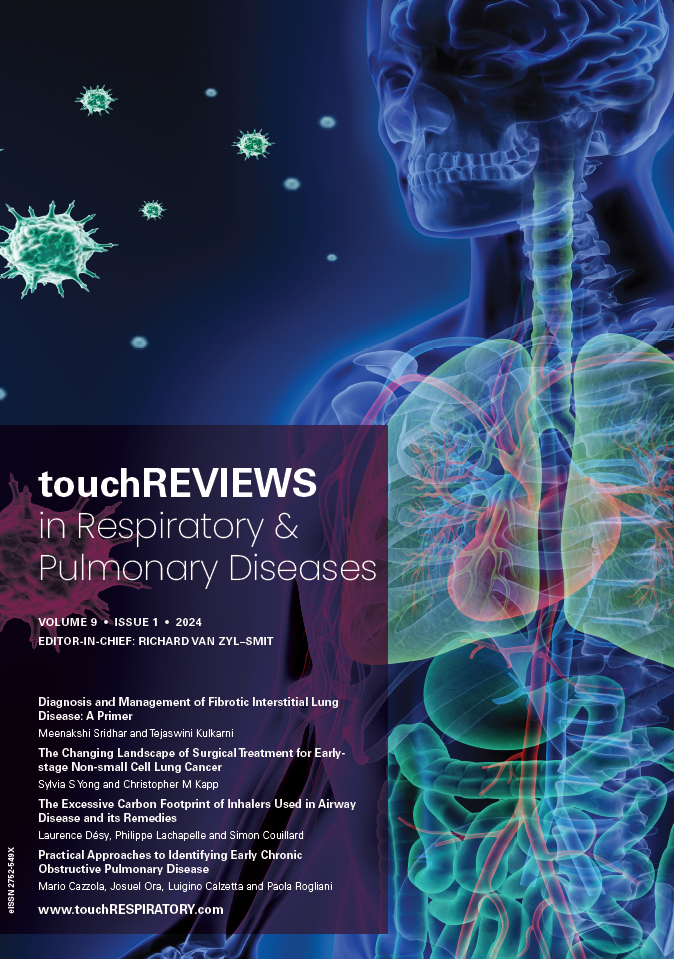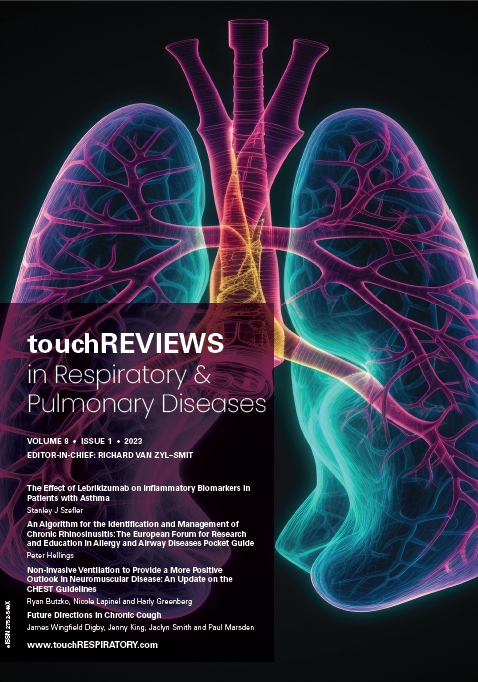touchREVIEWS in Respiratory & Pulmonary Diseases Volume 6, Issue 1, 2021
Welcome to our new issue of touchREVIEWS in Respiratory & Pulmonary Diseases. This free-to-access issue is full of topical content on a range of subjects, which we think will be of interest for you across the spectrum of respiratory & pulmonary medicine, including reviews around the treatment of Primary Ciliary Dyskinesia, NSAID-Exacerbated Respiratory Disease, Alpha-1 Antitrypsin Deficiency Lung Disease and much more.
We hope you’ll find something of interest in this issue, and we look forward to continuing to share new and exciting content into 2022 and beyond. Thanks to all who contributed and provided their expertise in putting together this edition, and to all of our authors, editorial board members and partners for their work this year. If you’re interested in contributing to our upcoming 2022 issues, please feel free to submit [here] or contact us directly.
Foreword
Welcome to the latest issue of touchREVIEWS in Respiratory & Pulmonary Diseases. The past three years have been intensely busy, chaotic and traumatic, especially for those of us working in the respiratory field. Having personally spent hundreds of hours only working in COVID-19-related critical care, I have missed out on many new developments in respiratory healthcare. […]
Editorial
Proton pump inhibitors (PPIs) are a class of antacid drugs that are available by prescription and over-the-counter to treat gastro-oesophageal reflux disease in patients with a number of comorbidities, including chronic respiratory diseases, such as asthma, pulmonary arterial hypertension, chronic obstructive pulmonary disease and idiopathic pulmonary fibrosis.1 Although they are generally regarded as safe and effective […]
Sleep disturbances are exceedingly common and potentially morbid in patients with neuromuscular diseases (NMD).1 A constellation of physiologic changes occur in patients with NMDs which, in concert with normal physiologic changes during sleep, lead to decreased nocturnal ventilation that often precedes daytime hypoventilation. The standard manner in which we diagnose and treat sleep disorders in this […]
Expert Interview
Bronchiectasis is a chronic pulmonary disorder characterized by permanent bronchial dilatation, which in some children may be reversible, and airway inflammation, and by cough and sputum production, as well as recurrent respiratory tract infections.1 Bronchiectasis is associated with poor quality of life for the child/adolescent and their parents, recurrent exacerbations and high cost to healthcare systems.2 […]
Reviews
Despite huge strides in the fight against TB, the WHO’s Global Tuberculosis Report 2019 ranked Bangladesh sixth among the countries with the highest number of TB cases (4% of the global total), and seventh among the top 10 countries with the widest gap between notified and incident TB cases.1 Funding for TB programmes remains challenging and an obstacle […]
Primary ciliary dyskinesia (PCD), previously known as immotile cilia syndrome, is a rare genetic disease characterized by abnormal ciliary function due to defects in the structure and/or function of motile cilia, leading to recurrent and chronic infections of the upper and lower airways as a result of impaired mucociliary clearance.1 PCD is predominantly inherited in […]
Aspirin-exacerbated respiratory disease (AERD) is a clinical triad of asthma, nasal polyposis and sensitivity to aspirin and other non-steroidal anti-inflammatory drugs (NSAIDs). These patients have severe sinopulmonary inflammation, often refractory to standard treatments.1 However, significant advances in the management of both asthma and nasal polyposis allow for new treatment options and management algorithms. This article aims […]
Alpha-1 antitrypsin (AAT) deficiency (AATD) is the second most common genetic disease to cause clinically significant lung disease, surpassed only by cystic fibrosis.1 AAT is a serine protease inhibitor primarily produced in hepatocytes, with a normal plasma level of 20–53 µM or 90–200 mg/dL and a half-life of 3–5 days.2 AAT is transported via the systemic circulation […]
The lack of well-validated biomarkers for monitoring disease activity, predicting future clinical outcomes and the effect of therapeutic interventions highlights the need to find new biomarkers in chronic obstructive pulmonary disease (COPD). In recent years, extensive research has gone into identifying and attempting to validate relevant diagnostic biomarkers of disease activity and therapeutic response.1 A […]
Respiratory syncytial virus (RSV) is a ubiquitous virus that causes annual epidemics of infection in young children in all parts of the world. In temperate regions, epidemics are seasonal, and predictable during the winter months. Approximately half of all infants develop their first RSV infection prior to their first birthday. By 24 months of age, […]
Chronic rhinosinusitis (CRS) is a heterogeneous inflammatory disease of the nose and paranasal sinuses that is prevalent worldwide, affecting 10–12% of adults.1,2 It is phenotypically classified by the presence or absence of nasal polyps. Chronic rhinosinusitis with nasal polyposis (CRSwNP) is estimated to affect up to 4% of the population, and consists of multiple endotypes that […]
Original Research
Asthma, classically defined as a chronic inflammatory disease of the lower respiratory tract, is a heterogeneous array of clinical disorders that differ in intensity, occurrence, triggers, comorbidities, genetics, clinical course and prognosis.1 It manifests as wheezing, cough, dyspnoea, chest tightness and fatigue.2 These manifestations can be episodic or permanent, and are usually associated with a variable, obstructive, […]

Trending Topic
Asthma affects nearly 300 million people worldwide.1 Despite a notable decline in age-standardized prevalence, mortality and disability-adjusted life years over the past three decades, the burden of asthma remains high in many countries including low-middle-income countries.2 Climate change is also predicted to significantly impact asthma and other respiratory-related conditions, as rising global temperatures lead to longer pollen […]
Journal Archive
US Respiratory & Pulmonary Diseases is a peer-reviewed, free-to-access, annual journal comprising review articles, case reports, practice guides, theoretical discussions, and original research. It features balanced and comprehensive articles written by leading authorities, addressing the most important and salient developments in the field of respiratory.
Latest articles videos and clinical updates - straight to your inbox
Log into your Touch Account
Earn and track your CME credits on the go, save articles for later, and follow the latest congress coverage.
Register now for FREE Access
Register for free to hear about the latest expert-led education, peer-reviewed articles, conference highlights, and innovative CME activities.
Sign up with an Email
Or use a Social Account.
This Functionality is for
Members Only
Explore the latest in medical education and stay current in your field. Create a free account to track your learning.

















